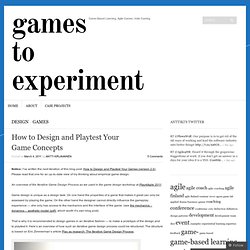

How to Design and Playtest Your Game Concepts « Game-Based Learning Dev. Notice: I’ve written the next iteration of this blog post: How to Design and Playtest Your Games (version 2.0).

Please read that one for an up-to-date view of my thinking about empirical game design. An overview of the Iterative Game Design Process as we used in the game design workshop at Play4Agile 2011. Game design is unique as a design task. On one hand the properties of a game that makes it great can only be assessed by playing the game. On the other hand the designer cannot directly influence the gameplay experience — she only has access to the mechanics and the interface of the game. That is why it is recommended to design games in an iterative fashion — to make a prototype of the design and to playtest it. The Puzzle Machine by Profound Whatever, on Flickr (CC non-commercial, attribution, share-alike) 1. The first step is to decide what are you going to design the game for. Objectives andConstraints. Objectives are statements about what the game should do.
Gate 1: Game Values 1.5. Reverse Brainstorming - Brainstorming techniques from MindTools. A Different Approach to Brainstorming © iStockphoto/Diva_Nir4a Reverse brainstorming helps you solve problems by combining brainstorming and reversal techniques.

By combining these, you can extend your use of brainstorming to draw out even more creative ideas. To use this technique, you start with one of two "reverse" questions: Instead of asking, "How do I solve or prevent this problem? " Instead of asking "How do I achieve these results? " How to Use the Tool Clearly identify the problem or challenge, and write it down.Reverse the problem or challenge by asking, "How could I possibly cause the problem? " Tip: Reverse brainstorming is a good technique to try when it is difficult to identify solutions to the problem directly. Example Luciana is the manager of a health clinic and she has the task of improving patient satisfaction. There have been various improvement initiatives in the past and the team members have become rather skeptical about another meeting on the subject.
And so it went on. 1001 Game Ideas Package. Game Design Process 101: Part II (Creative Thinking) For many people who want to be Game Designers, the most difficult thing about the process, aside from the actual work, follows soon after the initial spark of inspiration strikes.

More often than not, the first mistake a budding developer makes is to get inspired and immediate start the execution of the game’s design, usually after slapping together a whole lot of hype to get other people interested in his or her project. Screenshots, like an actual plan, are optional. A great example would be GamerJoe21 taking a shower, thinking about the ‘kick-ass war movie’ he saw last night where ‘that dude did that awesome thing with that minigun’. Don’t laugh, it’s probably happened numerous times… Game Design: Principles, Practice, and Techniques - The Ultimate Guide for the Aspiring Game Designer (9780471968948): Jim Thompson, Barnaby Berbank-Green, Nic Cusworth. Game Design: A Practical Approach (Charles River Media Game Development) (9781584504719): Paul Schuytema. Introduction to Game Development, Second Edition (9781584506799): Steve Rabin.
Game Design Workshop, Second Edition: A Playcentric Approach to Creating Innovative Games (Gama Network Series) (9780240809748): Tracy Fullerton.